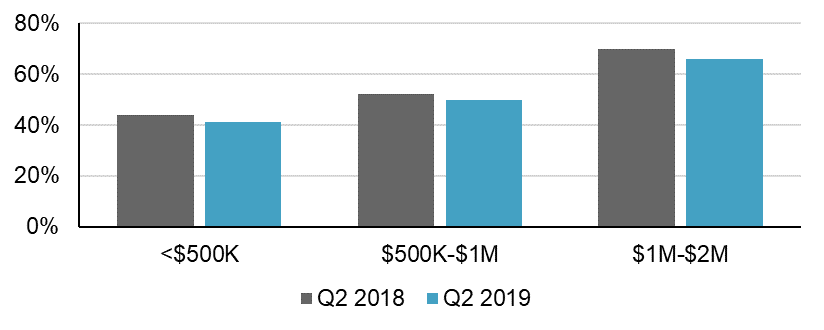The International Business Brokers Association Q2 2019 Market Pulse recently came out. In my opinion, this is one of the most insightful reports on the state of the market and includes the aggregate results of surveys conducted in July 2019 of 288 M&A Advisors. Insights include deal multiples, deal structure, types and motivation of buyers, the timing of the sale, and general commentary from advisors.
Here is the full report: IBBA Q2 2019 Market Pulse.
Here are the highlights for small businesses.
Hot Industries. For businesses valued less than $500,000, restaurants took the top slot (again) followed by personal services and consumer goods companies. The top selling industries for businesses valued between $500,000 and $1 million were construction/engineering, consumer goods, and business services.
Construction/engineering and business services companies lead among hot industries. This is the first time construction/engineering has held such a prominent share of market activity. “Construction activity is hot right now. Companies have strong balance sheets, so they’re expanding their facilities and state and local governments are reinvesting in roads. It makes sense that construction companies are selling now and getting out while things are good,” said Lisa Riley, LINK Business-Phoenix.
Who’s Buying? For businesses worth less than $1 million, first-time buyers and serial entrepreneurs dominated the market. Existing companies accounted for 18-20% of acquisitions in this space. The data shows that the smaller the company, the closer the buyer is likely to be located with 70% of <$500,000 buyers being located within 20 miles of their target business.
Buyers of businesses valued less than $500,000 tended to be:
• First time buyers (48%), serial entrepreneurs (32%), or existing companies (18%)
• Motivated to buy a job (53%), gain a horizontal add-on (21%)
• Located within 20 miles (70%) or more than 100 miles (17%) of the seller’s location
Buyers of businesses valued between $500,000 and $1 million tended to be:
• Serial entrepreneurs (49%), first-time buyers (27%), or existing companies (20%)
• Motivated to gain a horizontal add-on (36%), buy a job (29%), or realize better ROI than other investments (20%)
• Located within 20 miles (56%) or within 50 miles (24%) of the seller’s location
Multiples. Sale multiples continue to hold up, with median multiples of 2x SDE and 2.5x SDE for businesses valued below $500,000 and between $500,000 and $1 million, respectively.
Figure 1: Median Multiples Paid (SDE)

Deal Structure: Seller financing continues to remain very low, with most businesses receiving 80%+ cash at closing.
Figure 2: Percent Cash at Closing

Sentiment: Confidence is dropping across every sector through. Seller market sentiment in the $500,000 to $1 million sector dropped below 51% for the first time since Q3 2017. “It’s still a strong marketplace with more buyers than sellers…but tariff issues are popping up and talk of a recession in the next 12 to 18 months is scaring some buyers away,” noted Randy Bring, Transworld Business Advisors.
Figure 3: Seller’s Market Sentiment

Timing: The average time to close sub-$500,000 deals was 6 months, including 2 months post-LOI. $500,000 to $1 million deals took about 1 month longer on average.
Figure 4: Time to Close

Transition Planning: Retirement continues to lead as the number one reason to sell across all sectors, followed by burnout. The majority of Main Street business owners fail to plan for the sale of their business. Advisors indicated that 85% of business owners in the <$500,000 sector conducted no formal planning and did not meet with any type of advisor (e.g. CPA, wealth, attorney, broker) prior to engagement.
The Exit Planning Institute estimates there are more than 4.5 million businesses expected to transition in the next 10 years in the US. David Ryan, Upton Financial, commented, “We could see a shift in supply-and-demand as more Boomers go to market. That could change dynamics significantly and create some real pain points for retiring Boomer business owners.”
